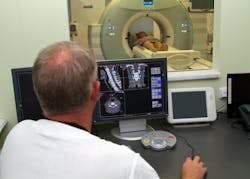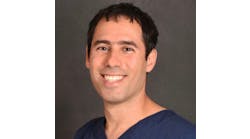A nationwide shortage of radiologists has been predicted for some time. Indeed, back in February 2022, Howard B. Fleishon, M.D., then chair of the Board of Chancellors of the American College of Radiology (ACR), wrote a blog about the subject. “In any industry, the ability to deliver goods and services is dependent on its workforce. Especially during the ongoing COVID-19 pandemic, workforce issues have been front and center — with employee shortages impacting service industries particularly hard,” Dr. Fleishon wrote. “Radiology has not been immune to these shortages. Due to a variety of factors — some unique to our profession — practices are feeling the pressure to provide more services while battling a lack of staff to accommodate the demands.”
Significantly, Fleishon noted, “Multiple sources have projected that the demand for medical imaging will continue to rise. In 2018, research and consulting firm Frost & Sullivan looked at utilization controls versus the growing Medicare population, which tends to have higher rates of medical imaging. They predicted that, at least in the intermediate term, the demand for services would continue to grow.2 Other sources documented the temporary decrease in services during the initial COVID-19 peak with a rapid bounce back after restrictions were lifted.”
What’s more, Fleishon wrote, “The demographics of our workforce need to be considered when looking at future needs. The current radiologist population is skewed toward seasoned professionals who may be looking at retirement. Of the 20,970 radiologists engaged in active patient care, 82 percent are age 45 and over, while 53 percent are age 55 and over. Our practices and departments have been dealing with the issue of radiologist burnout for several years,” he added. “Much has been researched and publicized about its impact. According to a recent study published in Mayo Clinic Proceedings, radiologists ranked fifth out of more than 23 surveyed specialties in their reported burnout rate. Increasing rates of burnout have been reported over several years.5 A 2020 Journal of Breast Imaging study found a high prevalence of burnout among breast imagers, particularly early-career professionals.”
And while it’s true that, as Fleishon noted, “The ACR has developed resources through its Radiology Well-Being Program to address the problem of burnout in the profession,” it’s also true that “Many practices have turned to alternative staffing models, including non-physician radiology providers (NPRPs) such as nurse practitioners, physician assistants, and registered radiologist assistants. While these NPRPs provide vital functions, the use of physician extenders has become very controversial within the College’s membership. Many concerns have been voiced about the quality of the services they provide and the potential for radiologist job displacement. The national organizations that advocate on behalf of the nurse practitioners have been aggressively lobbying for independent practice. The American Academy of Physician Assistants is looking to change physician assistants’ titles to “associates.” The ACR is aggressively addressing scope of practice (SOP) challenges with its SOP fund and is looking at the feasibility of developing radiology-specific SOP guidelines.” He also noted a growing shortage of radiology techs nationwide.
In that regard, this March, “The American College of Radiology® (ACR®) and the Radiology Business Management Association (RBMA), responded to a request for information (RFI) issued by the U.S. Senate Committee on Health, Education, Labor, and Pensions (HELP) regarding healthcare workforce shortages. ACR and RBMA highlighted workforce challenges in radiology, including a recent report from the Association of American Medical Colleges (AAMC) that projects the United States could see an estimated shortage between 37,800 and 124,000 physicians by 2034. AAMC estimates shortages in ‘other specialties,’ including radiology, to range from 10,300 to 35,600 physicians. Other workforce challenges such as physician burnout and an aging physician workforce were also emphasized as contributing factors to shortages.”
The March 23 announcement, posted to the association’s website, noted that “The associations recommended that Congress pass legislation to invest in additional Medicare-funded Graduate Medical Education (GME) residency slots. They specifically requested Congress fund GME slots designated for radiology, as well as reintroduce the Physician Shortage Reduction Act. This legislation would expand the number of federally supported medical residency positions by 2,000 annually for seven years, directly addressing the growing physician shortage.”
All of this is concerning, given both the actual shortages beginning to materialize healthcare system-wide, and the experience of burnout that so many radiologists have been reporting over the past several years. As everyone knows, diagnostic imaging utilization has increased rapidly, rebounding following the months of the COVID-19 pandemic when, for obvious patient and staff safety reasons, only very urgent diagnostic imaging procedures were approved. Now in late 2023, the utilization is higher than ever.
In an article entitled “Understanding and Appreciating Burnout in Radiologists,” published in July 2022 in the publication Radiographics, a journal of the Oak Brook, Ill.-based Radiological Society of North America (RSNA), and authored by Christopher R. Bailey, Allison M. Bailey, Anna Sophia McKenney, and Clifford R. Weiss, those authors wrote that “Medscape’s 2022 National Physician Burnout & Depression Report found that the top five factors contributing to burnout in physicians across medical specialties are as follows: too many bureaucratic tasks (60 percent of responders); lack of respect from administrators, employers, colleagues, and staff (39 percent); too many hours at work (34 percent); lack of autonomy over one’s life (32 percent); insufficient salary (28 percent); and frustrations related to the use of electronic medical records (28 percent).” What’s more, “For radiologists, another obvious factor that can contribute to burnout is social isolation. It takes a team of radiologists, nurses, technicians, and other specialists to run a successful department or practice, but diagnostic radiologists spend a sizable portion of their workday engaged in individual work.”
Indeed, the authors wrote, “Diagnostic radiologists work independently at siloed workstations or in independent reading rooms. They often communicate with referring providers virtually, and they rarely meet the patients they care for. Social isolation can be mitigated with shared reading rooms, localization of reading stations in clinical work areas, and virtual conferences with colleagues. However, it is not clear that sporadic interpersonal contact is sufficient to counteract the social isolation so inherent to the field. Production targets and expanding workloads also contribute to burnout in radiologists. Production targets are not unique to radiology, but without defined clinic schedules, a radiologist’s productivity depends on their own pace and efficiency rather than on controlled patient encounters. This workflow structure can produce an internal sense of urgency, which may become emotionally burdensome or exhausting over time. There may also be external pressures from health care systems for short turnaround times, often without consideration of list volume or study complexity.”
What’s more, the authors wrote, “Interventional radiologists may face additional stress related to interdepartmental dynamics. Specifically, the role of interventional radiology within the context of large health care systems is evolving. Interventional radiologists are sometimes viewed as technicians rather than proceduralists, leading to procedures being ordered in the same way as diagnostic imaging studies. This behavior directly takes away interventionalists’ autonomy to evaluate, recommend, and manage patients independently and devalues their expertise. In addition, viewing interventional procedures the same way as diagnostic imaging studies has led to the expectation of immediate service and procedures, which places further stress on interventionalists. Finally, as in many other fields, staffing shortages and COVID-19 exposures have also contributed to burnout in recent years.”
So, as I walk the exhibit floor at McCormick Place, and also attend educational sessions, next week during the annual conference of the Radiological Society of North America—RSNA—I will be fascinated to learn how much attention will be paid to the growing radiologist shortage issue, as well as to the ongoing, but also intensifying, issue of radiologist burnout. Yes, it’s absolutely true, artificial intelligence (AI) and machine learning (ML) are increasingly used both for diagnostics in imaging, as well as for such important uses as radiological study prioritization and ordering-physician notification of urgent, abnormal results.
But whatever uses AI and machine learning are put to, it will be increasingly important for leaders in the radiology world to consider the growing radiologist—and radiological tech—shortage nationwide, as well as radiologist burnout. Our healthcare delivery system simply cannot afford to wake up to a massive shortage of radiologists (and rad techs) five or ten years from now. Policy, payment, operational, training/educational, and technological solutions need to be explored now, not later. In that regard, RSNA23 will be fascinating to attend; I’ll be looking for signs and signals in this important area of concern.


